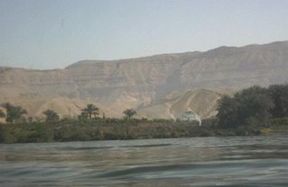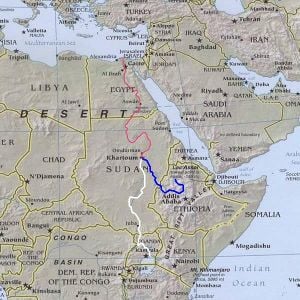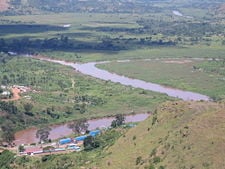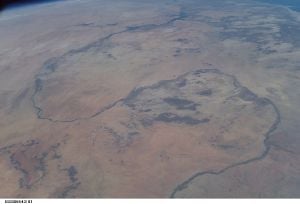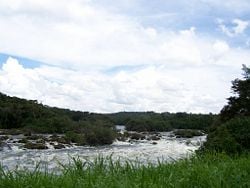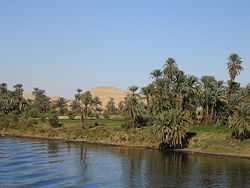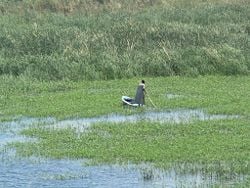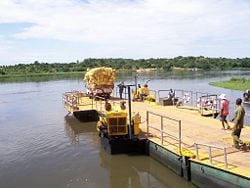| Nile | |
|---|---|
| | |
| Origin | Africa |
| Mouth | Mediterranean Sea |
| Basin countries | Sudan, Burundi, Rwanda, Democratic Republic of the Congo, Tanzania, Kenya, Uganda, Ethiopia, Egypt |
| Length | 6,695 kilometers (4,180 miles) |
| Source elevation | 1,134 meters (3,721 feet) |
| Avg. discharge | 2,830 meters³/sec. (99,956 feet³/sec.) |
| Basin area | 3,400,000 kilometers² (1,312,740 miles²) |
The Nile is one of the world's great waterways, at 4,180 miles (6,695 kilometers) generally regarded as the longest river in the world and among the most culturally significant natural formations in human history.[1] Flowing northward from remote sources in the mountains of Ethiopia and central Africa and draining into the Mediterranean Sea, the Nile has flooded seasonally over millennia to provide life-giving fertile soils and irrigation for Egypt's people. The drainage basin of the Nile encompasses about 10 percent of the area of Africa.[2]
Like the Tigris and Euphrates rivers in Mesopotamia in modern Iraq, the Nile provided a hospitable environment for the emergence of one of the earliest and most dominant civilizations in history. The river and its annual inundations played an important role in ancient Egyptian religion and cosmology. Most of the population of Egypt since ancient times and all its cities except those near the coast lie along those parts of the Nile valley north of Aswan, and nearly all the cultural and historical sites of ancient Egypt are found along its banks.
In modern times, the ten nations in the Nile Basin face perhaps their greatest challenge as they confront escalating demands for water, economic opportunities, and hydroelectric power. Pressed by their growing populations and water needs and projected drops in water flow as a result of climate change, all ten Nile basin countries have joined in a 1999 accord "to achieve sustainable socio-economic development through the equitable utilization of, and benefit from, the common Nile Basin water resources."
The ability to transcend national boundaries for the benefit of the greater cause is a necessary step not only in the care and sustenance of the Nile and its peoples, but also in the preservation and stewardship of the earth's natural resources in the face of unprecedented social and environmental challenges in the twenty-first century.
The Nile and its geography
The word "Nile" comes from the Greek word Neilos, meaning river valley. In the ancient Egyptian language, the Nile is called iteru, meaning "great river," represented by the hieroglyphs shown on the right.[3]
The Nile has two major tributaries. The Blue Nile is the source of most of the Nile's water and fertile soil, but the White Nile is the longer of the two. The White Nile rises in the Great Lakes region of central Africa, with the most distant source in southern Rwanda, and flows north from there through Tanzania, Lake Victoria, Uganda, and southern Sudan. The Blue Nile starts at Lake Tana in Ethiopia and flows into Sudan from the southeast. The two rivers meet near the Sudanese capital, Khartoum.
Both branches are on the western flanks of the Eastern Rift, the southern part of the Great Rift Valley. Another less important tributary is the Atbara, which flows only while there is rain in Ethiopia and dries quickly. The Nile is unusual in that its last tributary (the Atbara) joins it roughly halfway to the sea. From that point north, the Nile diminishes due to evaporation.
North of Cairo, the Nile splits into two branches that empty into the Mediterranean Sea: the Rosetta Branch to the west and the Damietta to the east, forming the Nile Delta.
White Nile
The source of the Nile is sometimes considered to be Lake Victoria, but the lake itself has feeder rivers of considerable size. The most distant stream emerges from Nyungwe Forest in Rwanda, via the Rukarara, Mwogo, Nyabarongo, and Kagera rivers, before flowing into Lake Victoria in Tanzania.
The Nile leaves Lake Victoria at Ripon Falls, near Jinja, Uganda, as the Victoria Nile. It flows for approximately 300 miles (500 kilometers) further, through Lake Kyoga, until it reaches Lake Albert. After leaving Lake Albert, the river is known as the Albert Nile. It then flows into Sudan, where it becomes known as the Bahr al Jabal ("River of the Mountain"). At the confluence of the Bahr al Jabal with the Bahr al Ghazal, itself 445 miles (720 kilometers) long, the river becomes known as the Bahr al Abyad, or the White Nile, from the whitish clay suspended in its waters. From there, the river flows to Khartoum.
The White Nile contributes approximately 31 percent of the yearly Nile discharge. During the dry season (January to June), however, the White Nile contributes between 70 and 90 percent of the total discharge from the Nile.
Blue Nile
The Blue Nile emerges from Lake Tana in the Ethiopian highlands, then flows about 850 miles (1,400 kilometers) to Khartoum, including sections that are channeled at great force through a narrow, rocky gorge. Once it joins the White Nile, they form the Nile. Some 90 percent of the water and 96 percent of the transported sediment carried by the Nile[4] originates in Ethiopia, with 59 percent of the water from the Blue Nile alone (the rest being from the Tekezé, Atbarah, Sobat, and small tributaries). The erosion and transportation of silt only occurs during the Ethiopian rainy season in the summer, however, when rainfall is especially high on the Ethiopian plateau.
Cataracts and Great Bend
Two features define the Nile between Khartoum and Aswan: the cataracts and the Great Bend. Since Roman times, the cataracts kept boats from going up and down the river between Equatorial Africa and Egypt and with the massive wetlands on the upper Nile south of Khartoum have shrouded the sources of the Nile in mystery for millennia. Though six are numbered, there are actually many more. The cataracts are also significant because these define river segments where granite and other hard rocks come down to the edge of the Nile. The floodplain is narrow to nonexistent, so opportunities for agriculture are limited. For these two reasons—navigation obstacles and restricted floodplain—this part of the Nile is thinly populated. The historic border between Egypt in the north and Nubia or Sudan in the south is the First Cataract at Aswan.
The Great Bend is one of the most unexpected features of the Nile. For most of its course, the Nile flows inexorably north, but in the heart of the Sahara Desert, it turns southwest and flows away from the sea for 300 kilometers before resuming its northward journey. This deflection of the river's course is due to tectonic uplift of the Nubian Swell. This uplift is also responsible for the cataracts; if not for recent uplift, these rocky stretches would have been quickly reduced by the abrasive action of the sediment-laden Nile.
Hydrology
It puzzled the ancients why the amount of water flowing down the Nile in Egypt varied so much over the course of a year, particularly because almost no rain fell there. Today we have hydrographic information that explains why the Nile is a "summer river."
The Nile south of the Great Bend in Sudan is really two hydraulic regimes: The White Nile maintains a constant flow over the year, because its flow is doubly buffered. Seasonal variations are moderated by the water stored in the Central African lakes of Victoria and Albert and by evaporation losses in the Sudd, the world's largest freshwater swamp. The Sudd reduces annual variations in streamflow since in unusually wet years, the area of the Sudd increases, which leads to larger losses to evaporation than during dry years, when the area of the Sudd is reduced. The result is that the White Nile issuing from the Sudd flows at about the same rate all year long, keeping the Nile downstream from Khartoum flowing during the winter months, when the Blue Nile/Atbara system has dried up.
The Blue Nile/Atbara system is a completely different hydraulic regime. It responds to the wet season/dry season variation of the Ethiopian highlands. In the winter, when little rain falls in the highlands, these rivers dry up. In the summer, moist winds from the Indian Ocean cool as they climb up the Ethiopian highlands, bringing torrential rains that fill the dry washes and canyons with rushing water that ultimately joins the Blue Nile or the Atbara. During the summer, the White Nile's contribution is insignificant. The annual flood in Egypt is a gift of the annual monsoon in Ethiopia.
After Aswan, there is less water due to evaporation of the Nile's waters during its leisurely passage through the Sahara Desert. Water is also lost due to human usage, so that progressively less water flows in the Nile from Atbara, the Nile's last tributary, all the way to the Mediterranean Sea.
Before the placement of dams on the river, peak flows would occur during late August and early September and minimum flows would occur during late April and early May.
History
The Nile has been the lifeline for Egyptian culture since the Stone Age. Climate change, or perhaps overgrazing, desiccated the pastoral lands of Egypt to form the Sahara Desert, possibly as long ago as 8000 B.C.E., and the inhabitants then presumably migrated to the river, where they developed a settled agricultural economy and a more centralized society.
As an unending source of sustenance, the Nile played a crucial role in the founding of Egyptian civilization. Bordering lands were extremely fertile due to periodic flooding and annual inundation. The Egyptians were able to cultivate wheat and other crops, providing food for the population and for trade. Also, the Nile’s water attracted game such as water buffalo and camels after the Persians introduced them in the seventh century B.C.E. These animals could be killed for meat or tamed and used for plowing—or in the camels' case, overland travel across the Sahara. The Nile itself was also a convenient and efficient means of transportation for people and goods.
Egypt’s stability was an immediate result of the Nile’s fertility. Flax and wheat could be traded. Trade, in turn, secured the diplomatic relationships Egypt had with other countries, and often contributed to its economic stability. The Nile also provided the resources, such as food or money, to quickly and efficiently raise an army.
The Nile played a major role in politics, religion, and social life. The pharaoh would supposedly flood the Nile, and in return for the life-giving water and crops, the peasants would cultivate the fertile soil and send a portion of the resources they had reaped to the pharaoh.
The Nile was so significant to the lifestyle of the Egyptians that they created a god, Hapi, dedicated to the welfare of the Nile’s annual inundation. Also, the Nile was considered a causeway from life to death and afterlife. The east was thought of as a place of birth and growth, and the west was considered the place of death, as the god Ra, the sun, underwent birth, death, and resurrection each time he crossed the sky. Thus, all tombs were located west of the Nile, because the Egyptians believed that to enter the afterlife, they must be buried on the side that symbolized death.
The Greek historian Herodotus wrote that "Egypt was the gift of the Nile," and in a sense that is correct. Without the waters of the Nile River for irrigation, Egyptian civilization would probably have been short-lived. The Nile provided the elements that make a vigorous civilization, and contributed much to its endurance for three thousand years.
The search for the source
Despite the attempts of the Greeks and Romans (who were unable to penetrate the Sudd), the upper reaches of the Nile remained largely unknown. Various expeditions failed to determine the river's source, thus yielding classical Hellenistic and Roman representations of the river as a male god with his face and head obscured in drapery. Agatharcides records that in the time of Ptolemy II Philadelphus, a military expedition penetrated far enough along the course of the Blue Nile to determine that the summer floods were caused by heavy seasonal rainstorms in the Ethiopian highlands, but no European in antiquity is known to have reached Lake Tana, let alone retraced the steps of this expedition farther than Meroe.
Europeans learned little new information about the origins of the Nile until the fifteenth and sixteenth centuries, when travelers to Ethiopia visited not only Lake Tana but the source of the Blue Nile in the mountains south of the lake. Although James Bruce claimed to have been the first European to have visited the headwaters, modern writers with better knowledge give the credit to the Portuguese Jesuit Pedro Páez. The deadly, tumultuous waters that passed through a narrow gorge near the headwaters deterred exploration until recent years.
The White Nile was even less understood, and the ancients mistakenly believed that the Niger River represented the upper reaches of the White Nile; for example, Pliny the Elder wrote that the Nile had its origins "in a mountain of lower Mauretania," flowed above ground for "many days" distance, then went underground, reappeared as a large lake in the territories of the Masaesyles, then sank again below the desert to flow underground "for a distance of 20 days' journey till it reaches the nearest Ethiopians" (Natural History 5.10).
Lake Victoria was first sighted by Europeans in 1858 when the British explorer John Hanning Speke reached its southern shore while on his journey with Richard Francis Burton to explore Central Africa and locate the Great Lakes. Believing he had found the source of the Nile on seeing this "vast expanse of open water" for the first time, Speke named the lake after Victoria, the queen of the United Kingdom. Burton, who had been recovering from illness at the time and resting farther south on the shores of Lake Tanganyika, was outraged that Speke claimed to have proved his discovery to have been the true source of the Nile when Burton regarded this as still unsettled. A very public quarrel ensued, which not only sparked a great deal of intense debate within the scientific community of the day but much interest by other explorers keen to either confirm or refute Speke's discovery. The well-known British explorer and missionary David Livingstone failed in his attempt to verify Speke's discovery, instead pushing too far west and entering the Congo River system instead. It was ultimately the American explorer Henry Morton Stanley who confirmed Speke's discovery, circumnavigating Lake Victoria and reporting the great outflow at Ripon Falls on the lake's northern shore.
The White Nile Expedition, led by South African Hendri Coetzee, was to become the first to navigate the Nile's entire length. The expedition took off from Uganda in January 2004 and arrived safely at the Mediterranean Sea four and a half months later.
In April 2004, geologist Pasquale Scaturro and his partner, kayaker and documentary filmmaker Gordon Brown, became the first to navigate the Blue Nile from Lake Tana to the Mediterranean, though first they trekked on foot from the springs in the Ethiopian highlands that feed the lake. Their expedition included a number of others, but Brown and Scaturro were the only ones to make the entire journey. However, the team was forced to use outboard motors for most of their journey, and it was not until January 2005, when Canadian Les Jickling and New Zealander Mark Tanner reached the Mediterranean, that the river was paddled for the first time under human power.
On April 30, 2005, a team led by South Africans Peter Meredith and Hendri Coetzee became the first to navigate what some believe to be the most remote headstream—the Kagera River, which starts as the Rukarara in Nyungwe forest in Rwanda and flows for 429 miles (690 kilometers) before reaching Lake Victoria. Others say that the true source is the Ruvyironza River, an upper branch of the Kagera that starts at Mount Kikizi in Burundi.
On March 31, 2006, three explorers from Britain and New Zealand, led by Neil McGrigor, claimed to be the first to travel the river from its mouth to its source in Rwanda's Nyungwe rainforest.
The river today
The Nile still supports much of the population living along its banks. However, construction of the Aswan High Dam (finished in 1970) to provide hydroelectricity ended the summer floods and their renewal of the fertile soil, since most of the silt carried by the Blue Nile settles in Lake Nasser.
Pressed by their growing populations and water needs, for the first time in history, all ten Nile basin countries (Burundi, Democratic Republic of Congo, Egypt, Eritrea, Ethiopia, Kenya, Rwanda, Sudan, Tanzania and Uganda) have expressed a serious concern about the need to work together to fight poverty. Guided by a shared vision adopted in February 1999—"to achieve sustainable socio-economic development through the equitable utilization of, and benefit from, the common Nile Basin water resources"—nine countries agreed to launch the Nile Basin Initiative (NBI), with Eritrea as observer, and at the same time decided to engage in negotiations for a permanent cooperative framework.
Excess water in Lake Nasser since March 2005 has been pumped by the Mubarak Pumping Station, said to be the largest of its kind in the world, into a canal through the Toshka Valley. Along the whole stretch, agricultural communities will be established wherever possible. The water is projected to irrigate a land of about 2,300 square kilometers that today is only desert. The government hopes to resettle up to three million inhabitants in the area. Experimental farms have shown that the soil is potentially fertile. Crops like cotton, cucumbers, tomatoes, watermelon, bananas, grapes, and wheat have all been successfully cultivated here.
The Nile north of Aswan is a regular tourist route, with cruise ships and traditional wooden sailing boats known as feluccas. In addition, many "floating hotel" cruise boats ply the route between Luxor and Aswan, stopping in at Edfu and Kom Ombo along the way.
Flora and Fauna
In the southern parts of the river, the hippopotamus and Nile crocodile are common. The Nile is also home to a variety of fish and birds, mostly in the southern part. Fish, especially the Nile perch and tilapia, are an important food source.
The upper regions of the Nile are in mountain forests, but as it travels north the vegetation around the river changes to shrubs and short trees, then no plants in the desert. In the river itself, water hyancinth and papyrus flourish. The latter was used for making paper, boats, sandals, and rope in ancient times.
The Eonile
The present Nile is at least the fifth river that has flowed north from the Ethiopian highlands. Satellite imagery was used to identify dry watercourses in the desert to the west of the Nile. An Eonile canyon, now filled by surface drift, represents an ancestral Nile called the Eonile that flowed during the later Miocene (23 to 5.3 million years ago). The Eonile transported clastic sediments to the Mediterranean, where several gas fields have been discovered within these sediments.
During the late-Miocene Messinian Salinity Crisis, when the Mediterranean Sea|Mediterranean was a closed basin and evaporated empty or nearly so, the Nile cut its course down to a new base level, until it was several hundred feet below sea level at Aswan and eight thousand feet deep under Cairo. This huge canyon was later filled in with sediment.
Formerly, Lake Tanganyika drained north into the Nile, until the Virunga Volcanoes blocked its course in Rwanda. That would have made the Nile much longer, with its longest headwaters in northern Zambia.
Notes
- ↑ River Encarta Encyclopedia. Retrieved April 25, 2007.
- ↑ Nile Watershed. World Resources Institute. Retrieved April 25, 2007
- ↑ “What did the ancient Egyptians call the Nile river?” Open Egyptology. Retrieved October 17, 2006.
- ↑ Marshall et al., “Late Pleistocene and Holocene environmental and climatic change from Lake Tana, source of the Blue Nile.” Holivar Natural Climate Variability and Global Warming. Retrieved April 25, 2007.
Sources and Further reading
- Bangs, Richard, and Pasquale Scaturro. 2005. Mystery of the Nile: the epic story of the first descent of the world's deadliest river. New York City: G.P. Putnam's Sons. ISBN 0399152628
- De Villiers, Marq. 2000. Water: The Fate of Our Most Precious Resource. New York: Houghton Mifflin. ISBN 0618030093
- Holmes, Martha, Gavin Maxwell, and Tim Scoones. 2004. Nile. London: BBC Books. ISBN 0563487135
- Morell, Virginia. 2001. Blue Nile: Ethiopia's river of magic and mystery. Washington, DC: Adventure Press. ISBN 0792279514
- The River Nile Homepage from the University of Texas at Dallas.
External links
All links retrieved November 14, 2022.
- Nile Delta – Earth from Space.
Credits
New World Encyclopedia writers and editors rewrote and completed the Wikipedia article in accordance with New World Encyclopedia standards. This article abides by terms of the Creative Commons CC-by-sa 3.0 License (CC-by-sa), which may be used and disseminated with proper attribution. Credit is due under the terms of this license that can reference both the New World Encyclopedia contributors and the selfless volunteer contributors of the Wikimedia Foundation. To cite this article click here for a list of acceptable citing formats.The history of earlier contributions by wikipedians is accessible to researchers here:
The history of this article since it was imported to New World Encyclopedia:
Note: Some restrictions may apply to use of individual images which are separately licensed.
